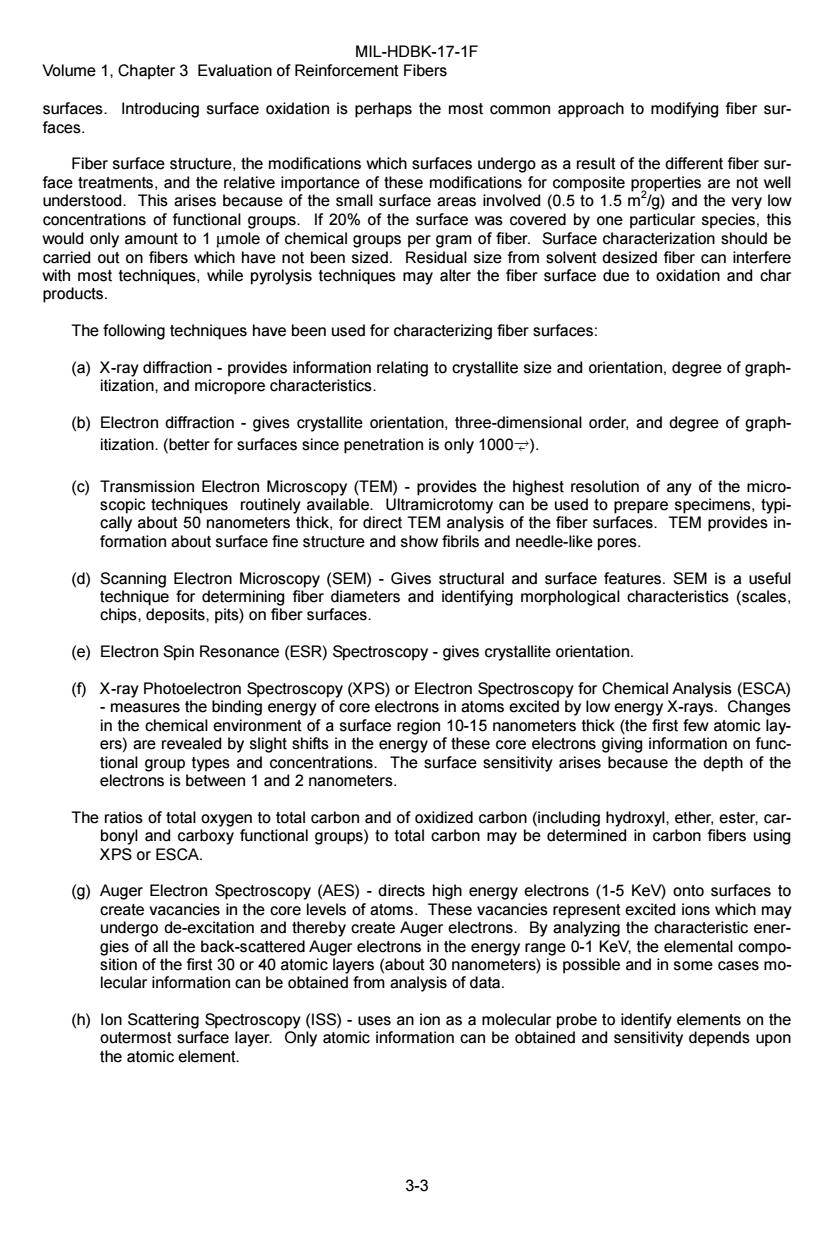正在加载图片...

MIL-HDBK-17-1F Volume 1,Chapter 3 Evaluation of Reinforcement Fibers surfaces.Introducing surface oxidation is perhaps the most common approach to modifying fiber sur- faces. Fiber surface structure,the modifications which surfaces undergo as a result of the different fiber sur- face treatments,and the relative importance of these modifications for composite properties are not well understood.This arises because of the small surface areas involved(0.5 to 1.5 m /g)and the very low concentrations of functional groups.If 20%of the surface was covered by one particular species,this would only amount to 1 umole of chemical groups per gram of fiber.Surface characterization should be carried out on fibers which have not been sized.Residual size from solvent desized fiber can interfere with most techniques,while pyrolysis techniques may alter the fiber surface due to oxidation and char products. The following techniques have been used for characterizing fiber surfaces: (a)X-ray diffraction-provides information relating to crystallite size and orientation,degree of graph- itization,and micropore characteristics. (b)Electron diffraction-gives crystallite orientation,three-dimensional order,and degree of graph- itization.(better for surfaces since penetration is only 1000-). (c)Transmission Electron Microscopy (TEM)-provides the highest resolution of any of the micro- scopic techniques routinely available.Ultramicrotomy can be used to prepare specimens,typi- cally about 50 nanometers thick,for direct TEM analysis of the fiber surfaces.TEM provides in- formation about surface fine structure and show fibrils and needle-like pores. (d)Scanning Electron Microscopy(SEM)-Gives structural and surface features.SEM is a useful technique for determining fiber diameters and identifying morphological characteristics (scales, chips,deposits,pits)on fiber surfaces. (e)Electron Spin Resonance(ESR)Spectroscopy-gives crystallite orientation. (f)X-ray Photoelectron Spectroscopy(XPS)or Electron Spectroscopy for Chemical Analysis(ESCA) measures the binding energy of core electrons in atoms excited by low energy X-rays.Changes in the chemical environment of a surface region 10-15 nanometers thick(the first few atomic lay- ers)are revealed by slight shifts in the energy of these core electrons giving information on func- tional group types and concentrations.The surface sensitivity arises because the depth of the electrons is between 1 and 2 nanometers. The ratios of total oxygen to total carbon and of oxidized carbon(including hydroxyl,ether,ester,car- bonyl and carboxy functional groups)to total carbon may be determined in carbon fibers using XPS or ESCA. (g)Auger Electron Spectroscopy (AES)-directs high energy electrons (1-5 KeV)onto surfaces to create vacancies in the core levels of atoms.These vacancies represent excited ions which may undergo de-excitation and thereby create Auger electrons.By analyzing the characteristic ener- gies of all the back-scattered Auger electrons in the energy range 0-1 KeV,the elemental compo- sition of the first 30 or 40 atomic layers(about 30 nanometers)is possible and in some cases mo- lecular information can be obtained from analysis of data. (h)lon Scattering Spectroscopy(ISS)-uses an ion as a molecular probe to identify elements on the outermost surface layer.Only atomic information can be obtained and sensitivity depends upon the atomic element. 3-3MIL-HDBK-17-1F Volume 1, Chapter 3 Evaluation of Reinforcement Fibers 3-3 surfaces. Introducing surface oxidation is perhaps the most common approach to modifying fiber surfaces. Fiber surface structure, the modifications which surfaces undergo as a result of the different fiber surface treatments, and the relative importance of these modifications for composite properties are not well understood. This arises because of the small surface areas involved (0.5 to 1.5 m2 /g) and the very low concentrations of functional groups. If 20% of the surface was covered by one particular species, this would only amount to 1 µmole of chemical groups per gram of fiber. Surface characterization should be carried out on fibers which have not been sized. Residual size from solvent desized fiber can interfere with most techniques, while pyrolysis techniques may alter the fiber surface due to oxidation and char products. The following techniques have been used for characterizing fiber surfaces: (a) X-ray diffraction - provides information relating to crystallite size and orientation, degree of graphitization, and micropore characteristics. (b) Electron diffraction - gives crystallite orientation, three-dimensional order, and degree of graphitization. (better for surfaces since penetration is only 1000S). (c) Transmission Electron Microscopy (TEM) - provides the highest resolution of any of the microscopic techniques routinely available. Ultramicrotomy can be used to prepare specimens, typically about 50 nanometers thick, for direct TEM analysis of the fiber surfaces. TEM provides information about surface fine structure and show fibrils and needle-like pores. (d) Scanning Electron Microscopy (SEM) - Gives structural and surface features. SEM is a useful technique for determining fiber diameters and identifying morphological characteristics (scales, chips, deposits, pits) on fiber surfaces. (e) Electron Spin Resonance (ESR) Spectroscopy - gives crystallite orientation. (f) X-ray Photoelectron Spectroscopy (XPS) or Electron Spectroscopy for Chemical Analysis (ESCA) - measures the binding energy of core electrons in atoms excited by low energy X-rays. Changes in the chemical environment of a surface region 10-15 nanometers thick (the first few atomic layers) are revealed by slight shifts in the energy of these core electrons giving information on functional group types and concentrations. The surface sensitivity arises because the depth of the electrons is between 1 and 2 nanometers. The ratios of total oxygen to total carbon and of oxidized carbon (including hydroxyl, ether, ester, carbonyl and carboxy functional groups) to total carbon may be determined in carbon fibers using XPS or ESCA. (g) Auger Electron Spectroscopy (AES) - directs high energy electrons (1-5 KeV) onto surfaces to create vacancies in the core levels of atoms. These vacancies represent excited ions which may undergo de-excitation and thereby create Auger electrons. By analyzing the characteristic energies of all the back-scattered Auger electrons in the energy range 0-1 KeV, the elemental composition of the first 30 or 40 atomic layers (about 30 nanometers) is possible and in some cases molecular information can be obtained from analysis of data. (h) Ion Scattering Spectroscopy (ISS) - uses an ion as a molecular probe to identify elements on the outermost surface layer. Only atomic information can be obtained and sensitivity depends upon the atomic element